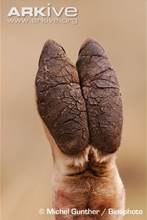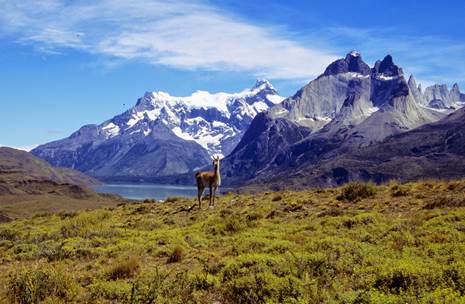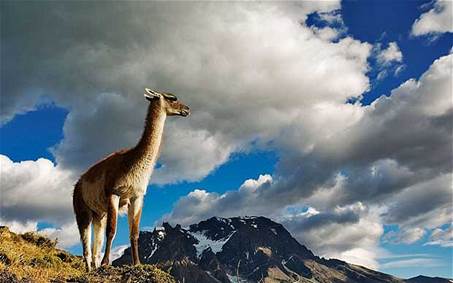The guanaco, or wild llama, is the characteristic quadruped of the plains of Patagonia; it is the South American representative of the camel of the East. It is an elegant animal in a state of nature, with a long slender neck and fine legs. It is very common over the whole of the temperate parts of the continent, as far south as the islands near Cape Horn. It generally lives in small herds of from half a dozen to thirty in each; but on the banks of the St. Cruz we saw one herd which must have contained at least five hundred. — Charles Darwin, December 23, 1833.
Guanacos are one of four members of South American Camelids (family Camelidae) – the domestic llama and alpaca, and the wild guanaco and vicuna. Camelids are even toed mammals with feet that lack functional hooves (like deer and moose) and the toe bones are embedded in a broad cutaneous pad – so two toes with toenails and soft pads.

Guanacos are the wild relative of llamas while vicunas are related to alpacas. Camelids (including camels – duh!) are large mammals with slender necks and long legs and are herbivorous. Camelids differ from true ruminants in several aspects including the presence of true canine teeth and a tusk-like premolar. While there is still some debate, there appears to be two distinct subspecies of guanacos. Guanacos stand 3-4 ft high at the shoulder and weigh up to 200 lbs. The name guanaco has its origins in the Quechua word for the animal – wanaku (or huanaco). Guanaco (a) also is slang for anyone from El Salvador and there is a very good Salvadoran restaurant in the University District of Seattle next time you’re over that way. http://www.yelp.com/biz/guanacos-tacos-pupuseria-seattle
The guanaco musculature is unique – while in deer for instance, the legs are attached to the body via both skin and muscle from the knee upwards, in Camelids the muscle attachments are much higher on the top of the thigh. Thus, Camelids must lie down by resting on their knees with their legs tucked under their body while a deer can sprawl at its pleasure. Guanacos have a three-chambered stomach instead of four and their upper lip is split into two so the left and right sides are independently mobile. When walking, both legs on the same side of the body are moved in tandem. Their blood contains about 4 times the amount of hemoglobin as human blood because they often live in areas up to 17,000 ft high and they have long eyelashes to protect their eyes in the arid and windy steppe.
Guanacos are native in the arid mountainous regions of South America and found in the altiplano (high plains) of Peru, Bolivia, Ecuador, Columbia, Chile, and Argentina. Herds consist of females, their young, and a dominant male. Young males will form separate herds that contain up to 50 animals until old enough to procure their own harem. They are one of the largest terrestrial mammals of South America and fall prey only to the mountain lion. They can run up to 35 mph and are quite agile over rocky terrain. If they feel threatened they will spit – though I don’t know how that would deter a mountain lion.
Females give birth to a single young each year – after a long gestation period of 35-360 days. Given the harsh environment and the long gestation period, a female has to be ready to mate within a few weeks of giving birth. Ovulation is induced by copulation. Newborns are able run and follow their mom almost immediately after birth. Young guanacos, called chulengos, weigh about 10% of their mother at birth. The youngster will stay with the group until it is 15 months old when it is usually forced out of the group by the adult male. Life is pretty tough for a young guanaco and mortality can be up to 70% for the first year of life due to predation, starvation, or accidents. Sexually maturity is reached in 12-24 months.
Males will spend 3-4 years with the bachelor herd competing for dominance and practicing fighting skills in preparation of competing for territory. Rivals fight by neck wrestling and chest ramming, often accompanied with growls and high-pitched screams – which reminds me of middle school and growing up with four brothers. Guanaco jousting: http://video.nationalgeographic.com/video/guanacos
The total population of guanacos at the time of European arrival has been estimated to have been between 30 and 50 million animals. Their population is considered stable today though much lower, with an estimated 550,000 – 590,000 in the wild throughout their range. There is some concern about the presence of large sheep herds in their range because there is an 80% overlap in their diet. In southern Patagonia and Terra del Fuego some ranchers consider the growing herds a threat to their privately owned rangelands and hunt them as pests.

This photo is from Torres de Paine National Park in the Patagonian region of Chile, which is home to a healthy guanaco population. About 20 years ago a friend and I spend a couple months climbing and trekking around Patagonia. After a week long trek in the hinterlands we had camped near the park entrance and without transportation, we managed a ride in the back of a small pickup from some friendly Argentinians. After a 50 minute bumpy ride we said goodbye and thanks.
We wandered around and came across a herd of guanacos and, without much of a telephoto lens and virtually no cover, I spent the better part of an hour following around several individuals attempting to get a decent photo while my partner sat and ate lunch and enjoyed the performance.
They were pretty wary and would manage to counter my maneuvers easily – and it felt like I was aboard a defective cutter horse trying to hem in an uncooperative rodeo cow. They didn’t spit toward me as they obviously viewed my clumsy approaches as no threat, but they did hum a bit now and then. Mission accomplished, or at least as best as it was going to get, we tromped back along the dusty road for an hour or so until another vehicle came by to charitably take us back to camp.
